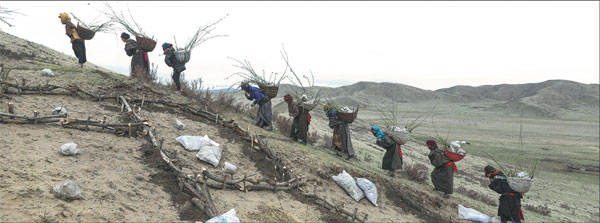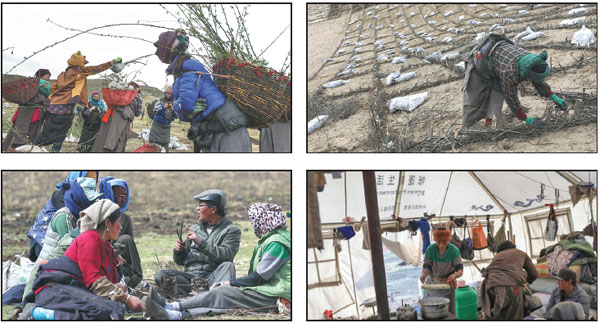Reclaiming the desert

Herdsmen work to plant the vital seeds that will help hold back the encroaching sands
In May, everything comes to life on the Ruo'ergai prairie in Sichuan province. Tibetan herdsmen transport organic fertilizer and protective screens, sowing grass seeds to prevent desertification. Soon, the bare sand dunes are covered with a patchwork of green. Desertification is caused by multiple factors - climate warming, rainfall reduction, rodents and excessive grazing. Early April to the end of May is a vital time for sand control, because highland willow and grass have a higher chance of survival if sown at this time of year. Ruo'ergai county has a total of 128 sand control spots, where people set up tents and live during the two months. According to the county's environmental protection and forestry bureau, from 2007 to date, 23,619.79 hectares of sandy grassland have been harnessed for sand control, accounting for 29 percent of the total desert in the region. By 2020, the county is expected to harness 42,984.5 hectares.
Xinhua
| Tibetan herdsmen carry baskets filled with highland willows in Ruo'ergai county, Sichuan province. Photos by Jiang Hongjing / Xinhua |
| Clockwise fromtop left: Willows are wrapped in a nutrient solution that can raise the survival rate; a herdsman uses highland willows tomake protective sand blocks; herdsmen prepare supper in a tent; herdsmen talk to an official (second fromright) about desertification. |
| Tents near one of the sand control spots in Ruo'ergai county. Herdsmen usually live there for 40 to 50 days. |
(China Daily Africa Weekly 06/16/2017 page4)
Today's Top News
- The farmer, the snake and Japan's memory hole
- Crossing a milestone in the journey called Sinology
- China-Russia media forum held in Beijing
- Where mobility will drive China and the West
- HK community strongly supports Lai's conviction
- Japan paying high price for PM's rhetoric

































